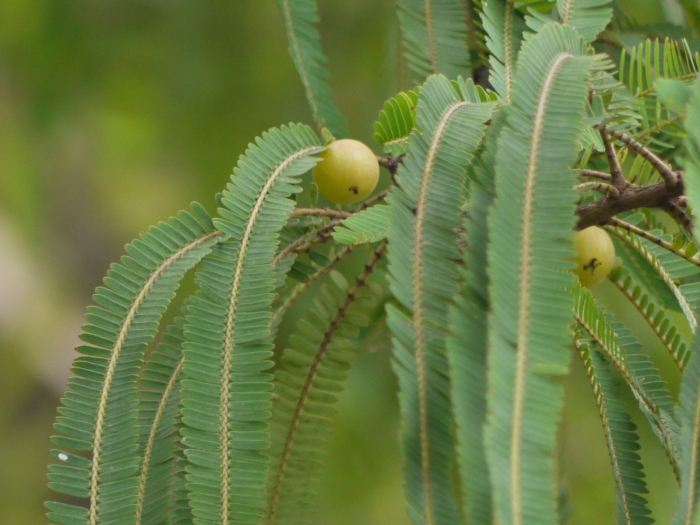Indian Gooseberry
(Phyllanthus emblica)
Indian Gooseberry (Phyllanthus emblica)
/
/

© Dinesh Valke
CC BY-SA 4.0
Image By:
© Dinesh Valke
Recorded By:
Copyright:
CC BY-SA 4.0
Copyright Notice:
Photo by: © Dinesh Valke | License Type: CC BY-SA 4.0 | License URL: http://creativecommons.org/licenses/by-sa/4.0/ | Uploader: dineshvalke | Publisher: iNaturalist |
























Estimated Native Range
Summary
Phyllanthus emblica, commonly known as Indian gooseberry or amla, is a deciduous tree that is part of the Euphorbiaceae family. It is native to tropical South and Southeast Asia, including India, Nepal, and Sri Lanka, where it thrives in forested and hilly areas. The tree typically grows between 3-26 feet tall and has a crooked trunk and spreading branches. The leaves are simple, subsessile, and light green, with an appearance that resembles pinnate leaves. The greenish-yellow flowers are inconspicuous and bloom from February to May, followed by nearly spherical, light greenish-yellow fruit that ripens in the autumn.
The amla fruit is highly valued for its high vitamin C content, which is more stable due to the presence of tannins that protect it from heat and light. In cultivation, Indian gooseberry is grown for its edible fruit, which is used in South Asian cuisine, traditional medicine, and Ayurveda. It is also planted as an ornamental tree for its attractive form and the cultural significance it holds in Buddhism. Amla trees prefer full sun to part shade, well-drained soil, and can tolerate a range of soil types, including clay and alkaline soils. They are drought-resistant once established but benefit from regular watering during the growing season.CC BY-SA 4.0
The amla fruit is highly valued for its high vitamin C content, which is more stable due to the presence of tannins that protect it from heat and light. In cultivation, Indian gooseberry is grown for its edible fruit, which is used in South Asian cuisine, traditional medicine, and Ayurveda. It is also planted as an ornamental tree for its attractive form and the cultural significance it holds in Buddhism. Amla trees prefer full sun to part shade, well-drained soil, and can tolerate a range of soil types, including clay and alkaline soils. They are drought-resistant once established but benefit from regular watering during the growing season.CC BY-SA 4.0
Plant Description
- Plant Type: Tree
- Height: 26-33 feet
- Width: 20-30 feet
- Growth Rate: Slow, Moderate
- Flower Color: Green, Yellow
- Flowering Season: Spring, Summer, Fall
- Leaf Retention: Deciduous
Growth Requirements
- Sun: Full Sun
- Water: Medium
- Drainage: Medium, Fast
Common Uses
Bird Garden, Edible*Disclaimer: Easyscape's listed plant edibility is for informational use. Always verify the safety and proper identification of any plant before consumption., Hedges, Low Maintenance
Natural Habitat
native to tropical South and Southeast Asia, including India, Nepal, and Sri Lanka, where it thrives in forested and hilly areas
Other Names
Common Names: Amalaki, Amla, Aonla, Emblic, Emblic Myrobalan
Scientific Names: , Phyllanthus emblica, Cicca emblica, Cicca macrocarpa, Diasperus emblica, Diasperus pomifer, Dichelactina nodicaulis, Dichelactina nodicaulus, Emblica arborea, Emblica officinalis
GBIF Accepted Name: